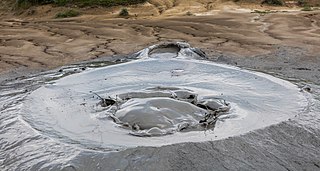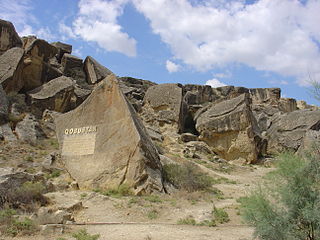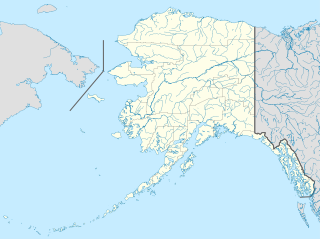 W
WA mud volcano or mud dome is a landform created by the eruption of mud or slurries, water and gases. Several geological processes may cause the formation of mud volcanoes. Mud volcanoes are not true igneous volcanoes as they do not produce lava and are not necessarily driven by magmatic activity. The Earth continuously exudes a mud-like substance, which may sometimes be referred to as a "mud volcano". Mud volcanoes may range in size from merely 1 or 2 meters high and 1 or 2 meters wide, to 700 meters high and 10 kilometers wide. Smaller mud exudations are sometimes referred to as mud-pots.
 W
WApaw-ye Kyun or Apaw Ye Kyun is an island off the coast of Rakhine State, Burma.
 W
WBaratang Island is an island of the Andaman Islands. It belongs to the North and Middle Andaman administrative district, part of the Indian union territory of Andaman and Nicobar Islands. The island lies 150 km (93 mi) north of Port Blair.
 W
WThe Berca Mud Volcanoes is a geological and botanical reservation located in Scorțoasa commune close to Berca in Buzău County in Romania. Its most spectacular feature is the mud volcanoes, small volcano-shaped structures typically a few metres high caused by the eruption of mud and natural gases.
 W
WChandragup is an active mud volcano located in Hingol National Park in Balochistan, Pakistan.Also known as Chandrakup, the volcano is considered holy by Hindus and is an important stop for pilgrims on their way to the shrine of Shri Hinglaj Mata temple.
 W
WDevil's Woodyard is one of the most visited locations of Trinidad's many mud volcanoes. Located in Hindustan in New Grant near Princes Town, the series of several vents appeared in 1852. As legend goes: "A relatively young volcanic site got its name after its first eruption in 1852. Which shook the entire village and fell the tall trees and frightened the Amerindian villagers. Villagers at the time believed that the devil had come from beneath the earth to fell the woods. The mounds of earth which occasionally bubble and hiss continue to amaze visitors of the site."
 W
WEl Totumo Mud Volcano is an active mud volcano located near sea level in northern Colombia in the municipality of Santa Catalina. A local tourist destination, popular for its alleged healing mud bath, it receives most of its visitors from nearby Cartagena. Along with this, it is the smallest volcano in the country. The mound has a prominence of about 15 m (49 ft) and it is accessible via a staircase that leads to the crater, which can accommodate about 10 to 15 people at a time; there, tourists bathe in the dense, warm mud and have the option of receiving personal massages from the attendants. The experience is then followed by a bath in a nearby lagoon to remove the mud.
 W
WGobustan State Reserve located west of the settlement of Gobustan, about 40 miles (64 km) southwest of the centre of Baku was established in 1966 when the region was declared as a national historical landmark of Azerbaijan in an attempt to preserve the ancient carvings, mud volcanoes and gas-stones in the region.
 W
WThe Hingol mud volcanoes are located in Lasbela District, Balochistan, Pakistan at a distance of around 100 km from Uthal, which is the headquarter of District Lasbela. The mud volcanoes are located in Hingol National Park which is the largest national park in Pakistan. It contains about ten clusters of mud volcanoes, the most important of which are Chandragup and Khandewari volcanoes.
 W
WThe Klawasi group is a cluster of three large mud volcanoes on the western flank of Mount Drum, a Pleistocene stratovolcano in the Wrangell Mountains of east-central Alaska in the United States. The cluster includes the Upper Klawasi, the Lower Klawasi and the Shrub.
 W
WAzerbaijan has the most mud volcanoes of any country, spread broadly across the country. 350 of the 700 volcanoes of the world are in the Azerbaijani Republic. Local people call them “yanardagh”, “pilpila” (terrace), “gaynacha” and “bozdag” alongside its geographical name – mud volcanoes.
 W
WNantha Kyun is an island off the coast of Rakhine State, Burma.
 W
WPiparo is a village in Central Trinidad on the southern edge of the Central Range. The village has three main claims to fame:Piparo was the base of operations of Dole Chadee, a notorious drug lord who was executed in 1999 for the murder of four members of the Baboolal family. Piparo was the home of Ras Shorty I during his self-imposed break from the soca world. Living simply in this rural community Ras Shorty-I developed Jamoo, a fusion of soca and gospel music. Piparo was the site of a large mud volcano eruption on February 22, 1997. The eruption covered an area of 2.5 km² and displaced 31 families. The mud volcano now lies active where the eruption took place.
 W
WPirgel is a mud volcano in Iran, in the province Sistan and Balochistan close to the town of Khash. The mud volcano is accessible via a foot track.
 W
WThe Sidoarjo mud flow is the result of an erupting mud volcano in the subdistrict of Porong, Sidoarjo in East Java, Indonesia that has been in eruption since May 2006. It is the biggest mud volcano in the world; responsibility for it was credited to the blowout of a natural gas well drilled by PT Lapindo Brantas, although some scientists and company officials contend it was caused by a distant earthquake.
 W
WSouth Chamorro Seamount is a large serpentinite mud volcano and seamount located in the Izu-Bonin-Mariana Arc, one of 16 such volcanoes in the arc. These seamounts are at their largest 50 km (31 mi) in diameter and 2.4 km (1.5 mi) in height. Studies of the seamount include dives by the submersible dives, drilling and, and ROV dives.
 W
WTakhti-Tepha Natural Monument is a landform created by the eruption of mud, slurries, water and gases in proximity of Takhti-Tepha mountain range. This mud volcano is located on plane, south of Dali water reservoir, at 620 m above sea level in Dedoplistsqaro Municipality, Georgia and incorporated in Vashlovani Protected Areas. Mud craters, along with small open vents are constantly active, erupting mud, oil and gas. The length of the pedestrian path across the Takhti-Tepha Natural Monument is 0.5 km. The total area of the natural monument is 9.7 ha. The largest mud cater is 3,5-4 m in diameter. The landscape is built of sandstones and clays.
 W
WTiga Island is one of a group of small uninhabited islands in Kimanis Bay off the western coast of Sabah, Malaysia. The islands were formed on 21 September 1897, when an earthquake on Mindanao caused a volcanic eruption near Borneo. The island is 607 hectares in size and has a couple of active mud volcanos at the highest part of the island. Tiga Island is one of the three islands that make up Tiga Island National Park. The Park Headquarters are on the island, comprising an office complex, and accommodation for the park staff and visiting scientists.
 W
WZalat Taung is an island off the coast of Rakhine State, Burma.